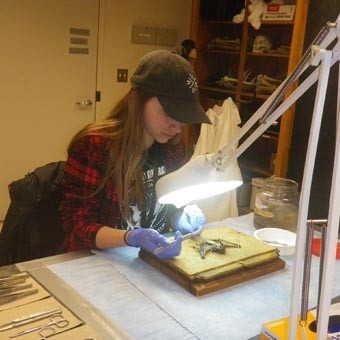“Plastination—The Art of Preservation” exhibit to embody GVSU’s plastination efforts

Courtesy / gvsu.edu
Oct 15, 2018
Grand Valley State University is currently showcasing an ongoing exhibit to start a conversation on the fusing of human, animal and plant tissues with a mixture of plastic or silicone products to render the tissues of any odor, followed by the tissues being preserved permanently dry for educational and instructional purposes—also known as “plastination.”
The exhibition is titled “Plastination—The Art of Preservation” and walks viewers through the process here at Grand Valley as it is the only plastination lab established in Michigan.
Joel Zwart, Exhibition Curator for GVSU, discusses the year and a half process taken to bring this exhibit to life.
“After the plastinates were selected, we brought them to our facilities to have our staff design and fabricate mounts for the exhibition,” Zwart said. “I worked on the development of the text panels, using colleagues as resources to accurately tell the story of the lab, the plastination process and how plastinates and the lab have become an invaluable teaching resource at GVSU.”
In 2007, biologist Bruce Ostrow spent a semester at the University of Michigan plastination lab. After spending various hours learning techniques and producing some of his own plastinates, Ostrow attempted to instill a plastination lab at GVSU; however, his efforts were unsuccessful until then-CLAS Dean Frederick Antzack made the dream a reality. He provided the funding in the spring of 2013, and after Antzack and anatomist Tim Strickler completed a workshop at the University of Toledo, they began to assemble the techniques and resources needed for GVSU’s first-ever plastination lab.
The lab at Grand Valley houses approximately 300 specimens that have been plastinated for a variety of instructional roles. Students are able to experience first-hand dissection because of the opportunities this lab offers.
“Although the exhibit shows only the non-human material we have produced because of regulations surrounding the public display of our human specimens, we do prepare quite a few human specimens for use in our BMS courses,” Strickler said. “A few bio courses as well as some of the students in the lab are involved in that work, too.
“I currently have 15 students working in the lab…about 30 percent of them are students I had in one of my anatomy classes, and others are folks who have a strong interest in anatomy and dissection.”
In addition, GVSU’s Art Gallery Vision Statement states, “To shape and enrich the quality of life for the residents and visitors of Grand Valley State University and to become a leader in the areas of art appreciation and interdisciplinary education for the local community.”
Joel Zwart explains that this vision is the driving force behind the gallery here at GVSU.
“At the Art Gallery, we are committed to the integration of art into all areas of the university and to support interdisciplinary learning,” Zwart said. “One of the ways in which we do this is through our exhibitions that reach out into the different disciplines at GVSU to tell their story. We’ve never done an exhibition like this before, but that’s the beauty of our work at the art gallery — we help share the art of plastination with GVSU and our community.”
“Plastination—The Art of Preservation” is currently showcased in the DeVos Center, displayed in the Blue Wall Gallery, Building B, located on the downtown Pew campus. The exhibition is open to the public and will be available until Dec. 14.























